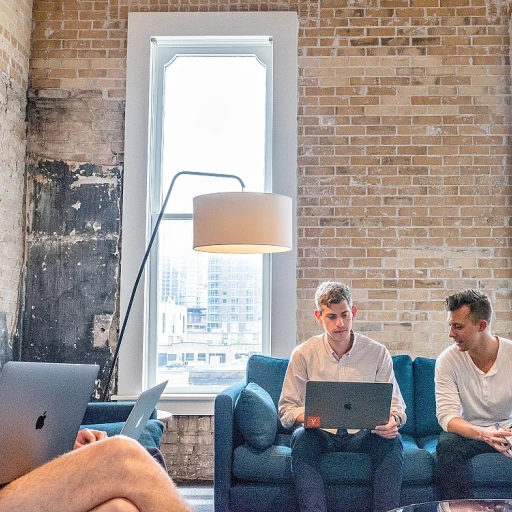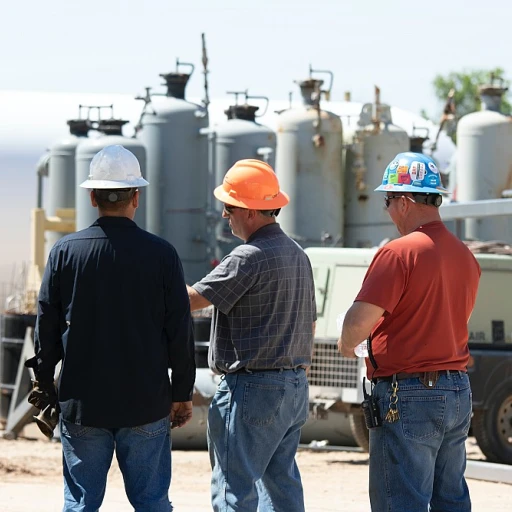The Role of Technology in a Smarter Workplace
Harnessing the Power of Smart Technology
The integration of technology into the workplace has fundamentally transformed how businesses operate, offering tools that enhance the efficiency of both employees and organizations alike. With the rapid adoption of intelligent workplace solutions, companies have embraced workplace technology to foster a more efficient work environment.
Smart workplaces are defined by their ability to leverage technology to create a smarter workplace. This transformation is evident in the widespread use of digital tools such as desk booking systems and Microsoft Teams, which facilitate hybrid work models by allowing employees to manage their schedules and collaborate effectively from anywhere. By incorporating such smart systems, companies can optimize office space by ensuring the intelligent use of resources.
An intelligent workplace is not just about convenience; it is about enhancing the employee experience. From real-time data analytics that help in making informed management decisions to digital signage that improves communication, these technologies contribute to a more engaged and productive workforce. The integration of technology within the work environment aids in the seamless operation of meeting rooms and simplifies processes through real-time information access.
For businesses looking to future-proof their operations, investing in smart office technologies is essential. By fostering collaboration and facilitating a simply smarter working approach, these advancements are pivotal in shaping today's—and tomorrow's—workplace landscapes. For further insights, you can explore more on
office design's future.
Remote Work and Flexible Schedules
The Rise of Remote Work and Flexible Schedules
The modern workforce has experienced a paradigm shift with the rise of remote work and flexible schedules. This transformation, catalyzed by advancements in technology, has altered the traditional office dynamics. Companies are now increasingly incorporating hybrid work models that blend remote and in-office setups, tailored to meet the evolving demands of their employees.
Employers are leveraging smart office solutions to enhance employee experience and productivity. Technologies such as digital signage, smart technology integration, and real-time digital workplace strategies aid in streamlining operations and making more intelligent workplace management decisions.
Benefits of Hybrid Work Models:
- Increased Flexibility: Offering flexible work schedules allows employees to balance personal commitments with work duties, leading to improved job satisfaction and engagement.
- Enhanced Collaboration: Tools like Microsoft Teams enable seamless communication and project management for distributed teams, fostering a collaborative work environment.
- Cost Efficiency: Companies can reduce overheads related to physical office space, such as rentals and utility expenses, by adopting a hybrid model.
- Wider Geographical Reach: Hiring globally expands the talent pool, helping businesses attract diversified skills and perspectives.
However, managing a hybrid work model isn't without challenges. Companies need to ensure that their employees have access to necessary workplace technology and resources, whether they are at home or in the office. Modern desk booking systems and meeting room management tools simplify these logistics, ensuring a seamless transition and integration into a smarter workplace.
Additionally, fostering a cohesive workplace culture in a hybrid work setting is essential. Implementing intelligent workplace solutions can help bridge the gap between remote and in-person interactions, ensuring that employees feel connected and valued regardless of their physical location.
The Importance of Continuous Learning
Embrace the Lifelong Learning Culture
In the evolving landscape of the modern workplace, maintaining a competitive edge requires more than just using the latest technologies. Companies are realizing the importance of fostering a culture of continuous learning among employees. This not only enhances individual skills but also equips organizations to adapt swiftly to changes.
The relentless pace of technological advancement means that skills can become outdated quickly. Employees need to keep up by continually acquiring new competencies. Various tools and platforms are available to help with this, ranging from online courses to internal workshops. By creating opportunities for both formal and informal learning, workplaces can ensure that their teams are equipped with the latest knowledge and skills.
A smarter workplace leverages technology to facilitate learning. Intelligent systems can recommend personalized learning paths based on employee performance and career goals, optimizing the learning experience. Integrating learning into the work environment seamlessly is crucial for a positive employee experience. An intelligent workplace can incorporate these learning platforms directly into existing workflow tools like Microsoft Teams.
Furthermore, data-driven decision-making in learning can provide insights into how effective different methods are, allowing companies to fine-tune their approaches. For instance, hybrid work environments can offer more flexibility in personalizing learning schedules. It's crucial for organizations to ensure that access to learning resources is no longer limited by one's physical presence in the office space.
To fully leverage these technological solutions, managers need to promote an environment where continuous development is encouraged and recognized as an integral part of the employee journey. This not only enhances overall employee engagement but also secures a smarter workplace that is adaptable in a rapidly changing world.
For those interested in developing sophisticated learning applications, exploring
AI-powered applications can offer valuable insights into how artificial intelligence can be harnessed to create effective learning solutions within the workplace.
Designing Workspaces for Collaboration and Innovation
Optimizing Spaces for Collective Brilliance
Designing office spaces that foster collaboration and innovation is a cornerstone of creating an intelligent workplace. As companies continue to embrace technology-driven solutions, understanding the role of the physical work environment becomes crucial. In this context, smart technology is reshaping how we view and utilize office space.
In a smarter workplace, traditional office layouts are being replaced with versatile spaces that accommodate various work styles. This transformation is driven by the need for hybrid work models, where companies blend the benefits of remote and on-site work. By implementing smart office systems such as desk booking and digital signage, employers can enhance the adaptability of their spaces to support both individual focus and team collaboration.
Smart workplaces incorporate advanced tools like real-time data monitoring and management systems to optimize the use of space. Whether it’s managing meeting rooms or ensuring a smooth employee experience, these intelligent solutions help improve efficiency and engagement.
Some organizations are even using employee feedback to create environments that support well-being. By closely observing how workspaces are used, businesses can make data-driven decisions that not only boost productivity but also enhance employee satisfaction.
The emphasis on flexible spaces aligns with the notion that creativity thrives in environments where people can interact effortlessly. Hence, the integration of workplace technology becomes a strategic tool for fostering a culture that values collaboration.
Ultimately, designing for collaboration and innovation is not just about physical furniture arrangements. It’s about creating an intelligent work environment that aligns with the evolving needs of employees and the business. As we move towards more complex and digital approaches, companies that prioritize this aspect will undoubtedly be better poised for future successes.
Data-Driven Decision Making
Harnessing Data for Strategic Decision-Making
In today's smart workplaces, leveraging data is key to making informed decisions. Workplace technology has evolved, enabling companies to access real-time insights that drive intelligent decisions. From desk booking systems to digital signage, smart technology aids in optimizing office space and improving the employee experience.
Smart offices utilize intelligent systems that collect and analyze data to streamline operations. For instance, digital tools such as Microsoft Teams facilitate seamless collaboration and enhance team efficiency. By understanding patterns in meeting room usage or employee engagement, management can make strategic changes that promote a healthier work environment.
In this intelligent workplace era, data-driven solutions empower teams to operate more efficiently. By analyzing trends and employee feedback, companies can anticipate needs and implement proactive solutions. This approach not only enhances productivity but also fosters a culture of continuous improvement.
The integration of hybrid work models also emphasizes the importance of data. Gathering information on how employees use office spaces and technology helps in designing effective hybrid solutions. The end goal is to create a workspace that supports both remote and in-office employees, ensuring a simply smarter work environment that adapts to the evolving needs of modern businesses.
The Impact of Workplace Culture on Employee Well-being
The Influence of Cultural Dynamics on Employee Satisfaction
The contemporary office isn’t just about advanced tools and smart technology, it’s also a space where workplace culture greatly affects employee well-being. As companies evolve into more intelligent workplace environments, they recognize the importance of a positive culture that nurtures both individual and team growth.
In smart workplaces, a supportive culture is key to fostering employee engagement and satisfaction. With an increasing trend towards hybrid work models, companies must prioritize creating a culture that transcends physical office boundaries. Employees now seek a consistent, inclusive experience whether working remotely or from the office space.
One of the solutions companies implement is the use of digital tools like booking software and digital signage that enhance the overall employee experience. These tools help in organizing hybrid work schedules more efficiently and ensure that employees feel connected regardless of their location. In this way, technology and culture weave together to craft a more cohesive work environment.
Moreover, the intelligent workplace relies heavily on real-time data to make informed decisions that benefit employee well-being. By leveraging management systems that provide insights into employee sentiments and productivity, companies can address issues proactively, resulting in a healthier work environment.
The role of workplace culture also extends to how spaces are designed for collaboration and innovation. Designing for a smarter workplace involves creating meeting rooms and collaborative zones that encourage creativity and foster teamwork. In these environments, employees can thrive, creating a sense of belonging and purpose.
As we move towards a future where hybrid work becomes the norm, a stronger focus on the cultural aspects of the office will help create simply smarter workplaces where employees are supported and motivated to excel. This approach not only improves individual satisfaction but contributes to the overall success of the organization.













